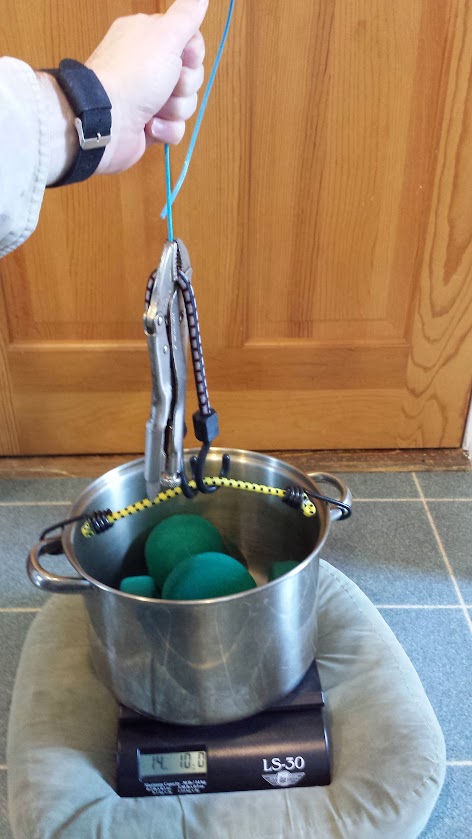I did the extruder weight test!
Quick answer: 12.1 pounds or 5.5 kg.
I used a bunjee cord that stretched more and more as the filament went up into the tube. I had the other end tied to weights on a scale and watched the "weight" drop down to lower and lower values as the extruder lifted more and more weight. I was at 3.3mm/sec extruder speed.
The extruder can definitely hold more weight when stopped. I repeated the experiment a few times. Everytime it failed it spun backwards (I was staring at it and watched it zip around backwards). Another way to say it is it missed steps rather than grind the filament.
I used the same light blue PLA from UM that I think you used nicolinux. I got a variation of only 2 ounces or 1%.
So my extruder had 10% to 50% more power than yours. Not sure how relevant this is as I'm not sure how repeatable your test was and how accurate. I should have taken a picture of my setup. I'll describe it in words:
I put a spaghetti pot on a scale, connected the two handles with very short bungee. inserted a 2 foot PLA. Clamped to the bottom with vice grips with bungee also going through vice grips grip. This second bungee reached both ends down to the bungee on the spaghetti pot. The spaghetti pot had 14 pounds of weights in it. After I was done I measured everything together including the weight of the vice grips. Subtracted total weight from the weight when it failed.













.thumb.jpeg.0b7a05eafc09add17b8338efde5852e9.jpeg)
Recommended Posts
Top Posters In This Topic
196
87
78
42
Popular Days
Jan 27
48
Jan 15
41
Jan 18
33
Jan 17
26
Top Posters In This Topic
Nicolinux 196 posts
gr5 87 posts
illuminarti 78 posts
braddock 42 posts
Popular Days
Jan 27 2014
48 posts
Jan 15 2014
41 posts
Jan 18 2014
33 posts
Jan 17 2014
26 posts
Nicolinux 288
Alright guys, I took the head apart. This time right down to the bone, you know, nozzle in hand and all.
I am pretty sure the nozzle is not blocked. Everything looks smooth right down to the nozzle tip. The teflon coupler looks fine too. I can slide filament without resistance. But there is a slight lip at the end where it sits on the nozzle:
So if I insert filament and push it sideways a bit, when I move it through, it cants/hangs a bit on its way out. Also the area where the teflon piece and the nozzle make contact is dark. Is some sort of coating or just some burnt stuff that got in there?
Next thing I found, the temperature sensor was covered in some gunk. Again it looks like something that got in there and burnt up completely. It fell off when I took it out of the heating block, and only a bit remained on the temp sensor:
And speaking of the sensor. It looks like a little piece is missing. It is not the mark from the screw that holds both the heating cartridge and temp sensor in place. Just a little pice is gone (or is this intended? I have no idea how the sensor works. I hope I am playing captain obvious, pointing out something that every temp. sensor has)
I think I need to file the lip away from the exit of the teflon coupler. I am not convinced that it is the cause for my problems though, because even with no retraction, my tests fail early and the filament is not moved back where it could hang on that lip.
Link to post
Share on other sites